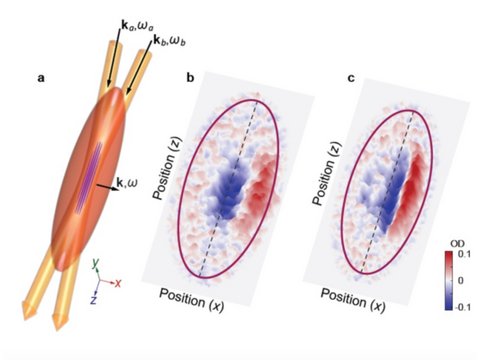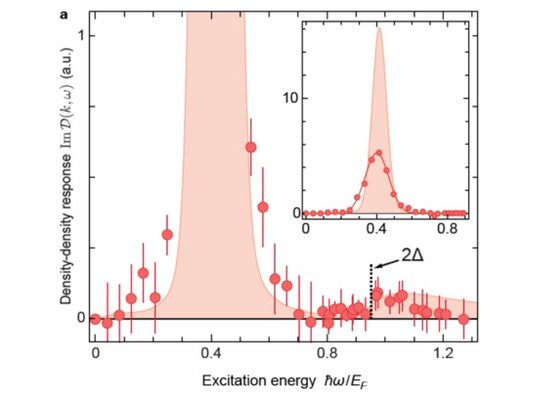From superconductor to BEC - going all the way!
Broken symmetry, superconduction and Goldstone-modes. Quantum simulator confirms theori in Aarhus-Helsinki-Melbourne collaboration
![[Translate to English:] Higgs-bosons from amplitude and Goldstone modes from phase](/fileadmin/site_files/nyheder/Goldstone-Higgs_diagram_UK.jpg)
Goldstone modes observed in cold Lithium-gas
A special kind of sound waves, called Goldstone modes have been observed for the first time, in a neutral fermionic super conductor consisting of ultra-cold 6Li-atoms. An important aspect of the result is that the experimental results fit very well with theoretical models developed a.o. in Aarhus. The proven exsistence of these Goldstone modes confirms our fundamental understandin of the mechanics behind superconductivity: That this fundamentally is a consequense of the spontaneous breaking by the superconductor of a quantum mechanical phase symmetry. The trailbreaking result is an example of the use of cold atomic gasses at quantum simulators for exploring problems that lie far outside the reach of classical computers.
The paper was recently published in Nature Physics, titeled:
Goldstone mode and pair-breaking excitations in atomic Fermi superfluids
Quantum computers and quantum simulators
Quantum computers are becoming the new black within physics and IT-development. The basic idea is that you can, by utilizing quantum mechanical effects, 'overtake' problems in conventional physics where we ar close to the limit of the physically possible ways of making the computers faster and smaller. Unfortunately it will be some time before a quantum computer is aviailable in a downtown shop!
Another type of computer exists, working in some sense in the opposite way. They can only solve one very specific problem, but on the other hand they do this extremely efficiently. We name these quantum simulatore, and already they excist in many places all over the World.
Theory and experiment in international collaboration
A group of researchers with participants from Melbourne, Australia, Helsinky in Finland and Aarhus University have recently published the results from such a new type of quantum simulator. This stems from a collaboration between theorticians and experimentalists. Georg M. Bruun from the Department of Physics and Astronomy, Aarhus University is behind a large part of the theoretical work.
In the engine room of quantum mechanics
The subject for the published paper lies deep in the engine room of quantum mechanics, but you don't have to be a quantum mechanic to understand the general principles! It deals with two physical phenomena: superconduction and the extremely cold state of matter that we call a Bose-Einstein Condensate (BEC).
Superconduction is a state of matter where electric currents in a wire meet no resistance at all. For half a century the effect has been known, but it took researchers 20 years to gain an understanding of what actually happens in the solid matter. For many years researchers have been trying to produce materials that show superconductivity at room temperatures. Succeeding in this will have enormous consequenses for conservation of energy. Imagine transmitting a current through a cable without loosing energy to electric resistance.
Superconductivity is caused by the electrons; belonging to a family of elementary particles named fermions, binding together two by two in socalled Cooper pairs. When forming these Cooper pairs the electrons automatically choose one specific phase symmetry of their wave function, meaning that they break the underlying phase symmetry.
A BEC is a special way of packing particles of another family, the bosons, at extremely low temperatures. This state of matter is relatively well understood from a theoretical point of view. Up to now there has not been any practical uses of a BEC, but to give an example of the weirdness of this state, it is in a BEC that it has been possible not only to stop light but also to start it moving again.
In many ways fermions and bosons are exact opposites, so one might think that superconductivity of electrons and Bose-Einstein condensation has very little to do with each other. Actually the two phenomena are closely related. Under special super cold conditions researchers can cause matter to change from one type to the other and back again: the superconducting state of fermions can be changed to be a BEC. Theoretically this transition is so complicated to follow by calculations that up to now it has been impossible to do in details, giving the researchers a deeper understanding of what happens during this transition. This is where the quantum simulator comes in!
From superconductor to BEC
In Melbourne the group of researchers have constructed a physcal setup enabling them slowly to change a very cold gas of 6Li-atoms from acting like a superconducting liquid into being a BEC. During the whole process it has been possible to follow and measure the transition. This succes has made it possible for the theoreticians a.o. in Aarhus stepwise to check the validity of the fundamental theoretical model for superconductivity and Bose-Einstein condensation. And lo and behold, the theory and the experiment comply beautifully all the way, confirming that our physical understanding of the process actually fits the real world!

Fig. 2: Two lasers hit an ultra cold cloud of 6Li-atoms, exciting vibrations in the phase φ, i.e. Goldstone modes. The vibrations cause oscillations in the gas density, i.e. sound waves.
Broken symmetry and phase transitions
To dig a bit deeper into the present new result a slight understanding of two basic subjects in physics is nescessary: breaking of symmetries and phase transitions.
In both cases we deal with phenomena in quantum mechanics of which we have no everyday experiences at all, so the best we can do is trying to find an analogy.
An ordinary magnet of iron is a classical (but in all details explainable by quantum mechanics only) example of symmetry breaking. In an ordinary piece of iron the electrons are pointing in totally random directions - an the physicists a litte backwards call this state a state of high symmetry. If you cool the iron or place it in a strong magnetic field the socalled spin directions of the electrons will spontaneusly align in large zones of the material, and if enough electrons are thus aligned the piece of iron has been made into a permanent magnet - a breaking of symmetry has occurred.
One type of phase transition we experience when forgetting a bottle of water in the deep freezer: Liquid water turns to solid ice when sufficiently cooled.
Inherited in the explanation for superconductivity is, that also here symmetry is broken, i.e. the phase symmetry of the quantum mechanical wavefunction describing the superconducting Cooper-pair. Simply said the wavefunction chooses one definite phase. A direct consequense of this explanation model is that the superconductor can experience oscillations in the phase, and this again causes supercurrents and soundwaves. It is these internal oscillations that are named Goldstone-modes. This kind of soundwaves are transporting the electrons in the superconductor. The problem is, though, that Goldstone-modes have never been observet in a superconductor! The reason is that the electric Coulomb-repulsion is strong enough to totally dominate the behavyor of the soundwaves. This has made it impossible up to now to check if the theory is correct.

Fig. 3: The Goldstone-mode is seen here as a wide peak in the spectrum. The dots are experimental measuremente and the coloured area represents the theory.
And now for the quantum simulator:
During the experiment a gas of 6Li-atoms is cooled suficcienty to make it behave like a superconducting material. As 6Li-atoms are fermions, we call this state a Fermigas. The wellbehaved little atoms pack themselves two by two in Cooper-pairs, causing the breaking of symmetry, just like if they were electrons in a superconductor. The great difference here is that now we deal with atoms which are not electrically charged seen from the outside, so the Colulomb-repulsion is absent. This is what saves the day! With a pair of lasers the researchers now push the atoms in the gas rythmically, and in this way for the first time ever, Goldstone-modes in a superconductor are observed.
If you push the pairs of Lithiumatoms harder, eventually the two atoms in the pairs are gradually pushed further and further away from each other, and at long last they loose the individual coupling, re-establishing the symmetry, just like if you heated the iron magnet sufficiently to make it stop being magnetic. During all of this decoupling the behaviour of the soundwaves fit exactly to the theoretical predictions, and this was a very happy surprise. It is notoriously difficult to predict what happens in strongly interacting quantum-systems.
Finally, at the limit where the soundwaves were bound in molecules, forming a Bose-Einstein condensate, they were measured again. And again the experimental results fit the theory developed partly in Aarhus.
Physical experiments simulate a complicated theory
The new result demonstrate how ultracold atomic quantum gasses can be used as quantum simulators. This is because atomic gasses are very flexible, enabling the researchers to taylor-make the parameters to the study of quantum mechanical problems being far too complicated to solve on a conventional computer. One could describe them as highly specialized quantum computers being able to solve just one single problem, unsolvable by ordinary means.
This kind of quantum simulators are already being used in lots of laboratories around the world. You will have to wait a bit longer for the much talked about quantum computer.
